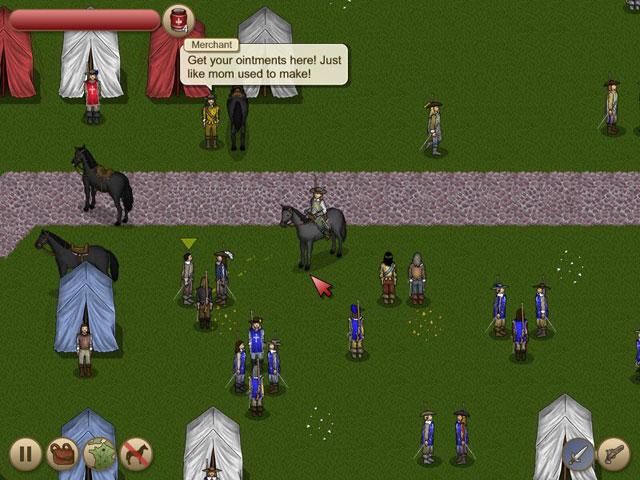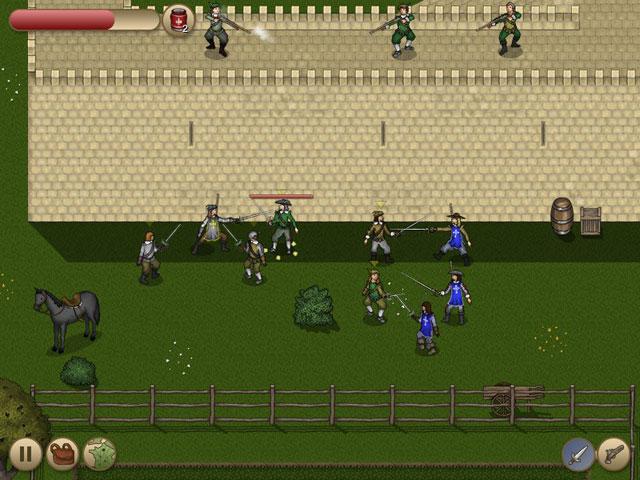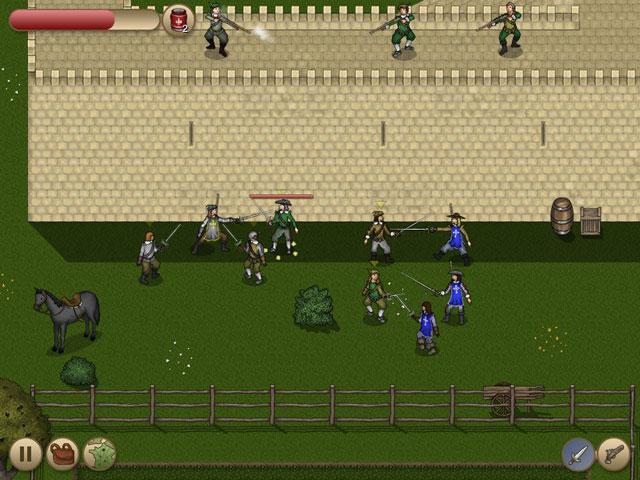- Wondering how to get Monopoly GO! free rolls? Well, you’ve come to the right place. In this guide, we provide you with a bunch of tips and tricks to get some free rolls for the hit new mobile game. We’ll …
Best Roblox Horror Games to Play Right Now – Updated Weekly
By Adele Wilson
Our Best Roblox Horror Games guide features the scariest and most creative experiences to play right now on the platform!The BEST Roblox Games of The Week – Games You Need To Play!
By Sho Roberts
Our feature shares our pick for the Best Roblox Games of the week! With our feature, we guarantee you'll find something new to play!All Grades in Type Soul – Each Race Explained
By Adele Wilson
Our All Grades in Type Soul guide lists every grade in the game for all races, including how to increase your grade quickly!
The Three Musketeers: Queen Anne’s Diamonds Review
In 1844, Alexandre Dumas published The Three Musketeers, a rousing tale of friendship and honor set in France in the 1600s. The story has been adapted numerous times over the years for television, film, stage and more, and now Dingo Games has put its own spin on the saga with the new RPG/adventure game called simply The Three Musketeers. But while Dumas’ novel has endured to become one of the famous literary works of all time, the video game is proof that great source material does not guarantee a great game.

In 1844, Alexandre Dumas published The Three Musketeers, a rousing tale of friendship and honor set in France in the 1600s. The story has been adapted numerous times over the years for television, film, stage and more, and now Dingo Games has put its own spin on the saga with the new RPG/adventure game called simply The Three Musketeers. But while Dumas’ novel has endured to become one of the famous literary works of all time, the video game is proof that great source material does not guarantee a great game.
In The Three Musketeers, players step into the boots of young D’Artagnan as he sets out to join the ranks of the famous Musketeers, making his way across the French countryside and eventually to the capital of Paris. Once there, he makes the acquaintance of Athos, Porthos and Aramis, the three musketeers of legend, beginning a friendship – after a rocky start – that will lead through countless adventures and ultimately help shape the very fate of France itself.
The game takes place in a top-down world composed of various villages and towns, each a small collection of houses and people. The French countryside is rather corridor-like, with excessive wandering prevented by trees and farmers’ fields, but there is a good chunk of territory to explore if you have the patience for it. In-game graphics are blocky and unremarkable, but have a certain retro charm to them; the hand-drawn interludes that advance the plot, on the other hand, are decidedly ugly, although a couple of frames did elicit some genuine, out-loud-laughter. The music is generally quite good and obsessive Achievement hunters will be pleased to hear that the game has many to collect.

Unfortunately, The Three Musketeers isn’t quite as impressive as it sounds. It suffers from several serious flaws, perhaps the most fundamental being that it’s not entirely accurate to call it an RPG at all. As a well-established character, D’Artagnan is essentially carved in stone from the beginning of the game and while a very basic set of character attributes – Attack, Defense, Honor and Shooting – will increase as players progress, points will be assigned to each category automatically. It’s impossible to develop D’Artagnan in any way beyond how he is defined by the game.
Similarly, the role playing options are almost completely limited to doing what D’Artagnan did in the Dumas’ famous novel. The game is faithful to the original story to a fault, so the illusion of choice – the backbone of any good RPG – is completely out the window. As you make your way through the game, you will either follow very closely in D’Artagnan’s footsteps, when and how the game instructs you, or you won’t get very far.
Which isn’t to say the game is completely linear. In fact, the whole of France, in game terms at least, is wide open and features well over a dozen side quests to be completed along with the main plot. From D’Artagnan’s hometown of Tarbes, through various towns and villages to Paris itself and even across the English Channel into London, players can roam the countryside map on foot and horseback, wandering through houses, inns and shops, talking to people and exploring as they see fit.
The trouble is, there’s just no point in bothering. Just about every non-critical character in the game speaks only a single throwaway line of text and never moves from a preset location. Houses are largely identical and their occupants are utterly indifferent to your presence, standing silently as you ransack their property. Random combat encounters offer a smattering of experience and loot that can be handy in the early stages of the game but eventually become little more than speed bumps. The game world never comes to life, and so it never seems worth paying much attention to; the lack of depth and detail reduces it to nothing more than an uninteresting, static backdrop.
Random exploration can lead to side quests, although some remain locked until the player has reached an appropriate level, but none of the half-dozen I completed were particularly interesting. In one, I had to find a woman’s lost dog, which was standing in plain sight a short distance from her house, right along the main road – you’d have to be playing with your eyes closed to miss it. I spent some time on a tennis mini-game, which is just a prettier Pong with slightly more irritating controls, and I was also asked to stop a cheese merchant from spreading vicious lies about a competitor. The cheese merchant, however, was escorted by cheese mercenaries (seriously, “cheese mercenaries”) and any hope of an amusing, conversational conclusion was lost as the encounter immediately spiraled downward into yet another bout of shooty, stabby combat.


Ah, the combat. Life is cheap in France of the 1600s and D’Artagnan spends a lot of time defending his honor against every sort of insult. You will spend much of the game in combat against many and varied villains, ranging from riff-raff who insult ladies in the street to the notorious Cardinal’s Guards, the personal goon squad of the dastardly Cardinal Richilieu. Like the rest of the game, the combat leaves much to be desired. It’s a fire-and-forget affair: Click on the enemy you want to kill, then stand back and wait. Opponents will occasionally lose their focus in the heat of combat, allowing for “super lunges” that do extra damage, and once players have acquired a pistol or musket they’ll be able to squeeze off a shot in combat that deals a grievous blow to a single enemy, but otherwise there is very little to do in battle beyond clicking on healing ointments when they become necessary.
And that is The Three Musketeers in a nutshell: Not much to do but click when and where the game tells you to. Fairly early on, for example, your travels will lead you to a priest who wants you to investigate the suspicious behavior of a grave digger; speaking to the grave digger will reveal that he harbors the same concerns about the priest. But there’s no possibility to investigate beyond a single line of conversation for each, and the only way to resolve the situation is to report to each that the other is up to no good – despite there being absolutely no indication that such is the case – after which the entire matter is forgotten.
Dedication to the source material just can’t overcome the stumbles in execution and in the end, The Three Musketeers misses the mark. There’s not enough going on to keep most adults interested and while younger gamers might have fun with it, parents should be aware that violence in the game, while not graphic, is plentiful. There are also a couple of implied sexual encounters, complete with cheesy “wah-wah” guitar riffs. With little for the player to do but click when instructed, it feels less like a game than it does an interactive novel, albeit a super-condensed novel that lacks any sort of background or narrative that might help give it context. In that light, you’re better off spending this month’s game budget on a copy of the book instead. It’ll last longer, make more sense and you’ll probably have a lot more fun with it, too.

The good

The bad
More articles...
Monopoly GO! Free Rolls – Links For Free Dice
By Glen Fox
Wondering how to get Monopoly GO! free rolls? Well, you’ve come to the right place. In this guide, we provide you with a bunch of tips and tricks to get some free rolls for the hit new mobile game. We’ll …Best Roblox Horror Games to Play Right Now – Updated Weekly
By Adele Wilson
Our Best Roblox Horror Games guide features the scariest and most creative experiences to play right now on the platform!The BEST Roblox Games of The Week – Games You Need To Play!
By Sho Roberts
Our feature shares our pick for the Best Roblox Games of the week! With our feature, we guarantee you'll find something new to play!All Grades in Type Soul – Each Race Explained
By Adele Wilson
Our All Grades in Type Soul guide lists every grade in the game for all races, including how to increase your grade quickly!







